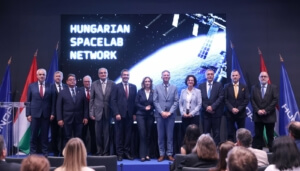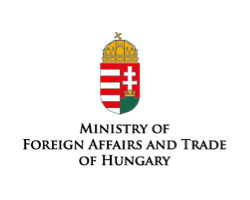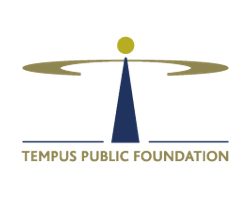
2025-08-12
Hungary is entering a new era of bold, globally visible scientific excellence. Recent years have seen groundbreaking innovations—from Hungarian-speaking AI and laser disease diagnostics to particle physics and autonomous drones. With astronaut Tibor Kapu’s launch into orbit, even the sky is no longer the limit. Once a quiet contributor, Hungary is now shaping the future of global science.
1. Lift-off: Hungary Reaches for the Stars
Tibor Kapu became Hungary’s first astronaut in over 40 years when he launched to the International Space Station aboard Axiom Mission 4, carrying out a suite of Hungarian-developed experiments under the HUNOR program. Following in the footsteps of Bertalan Farkas, who flew in 1980, Kapu represents a new chapter in Hungarian space research. His mission in microgravity spans biology, medicine, fluid dynamics, navigation, and even plant biology. From testing microfluidic drug delivery devices and measuring radiation with nanosensors to studying plant growth in low-selenium conditions and observing transient luminous events from orbit, Kapu’s journey highlights Hungary’s bold return to space science. Explore how ELTE and BME covered the mission’s scientific experiments.

At bottom left, Kapu Tibor poses with the rest of the Axiom Mission 4 (Ax-4) crew, joined by members of the Expedition 73 team in a group portrait aboard the International Space Station. Image credit: NASA
2. Laser-Sharp Vision: Nobel Science Meets Everyday Health
Back on Earth, another Hungarian is changing the future of medicine—at the speed of light. Nobel laureate Ferenc Krausz and his team are pioneering a diagnostic method that uses ultra-fast lasers and artificial intelligence to detect chronic diseases from a single drop of blood. This “molecular fingerprinting” technique is already showing remarkable accuracy in identifying conditions such as cancer, diabetes, and hypertension. A long-term study involving 15,000 participants is now underway in Germany and Hungary to validate the results. For a country with strong traditions in both physics and medicine, this is a landmark moment: Nobel-level research moving from the lab bench to potentially life-saving applications. Read more about it HERE.
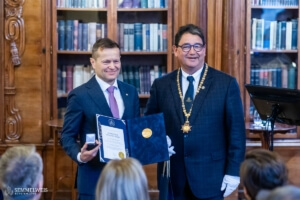
On the left, Nobel laureate Dr Ferenc Krausz is presented with the 2024 Semmelweis Budapest Award by Rector Dr Béla Merkely during a ceremony at Semmelweis University. Image credit: Semmelweis University
3. Hungarian Contribution to CERN Breakthrough Prize
Hungary is also contributing to the biggest questions in fundamental science. In 2025, four major experiments at CERN—including ALICE, ATLAS, CMS, and LHCb—were awarded the prestigious Breakthrough Prize in Fundamental Physics.
The Breakthrough Prize was founded in 2012 with the mission to annually celebrate individual achievements and recognise scientists as heroes of our society, to inspire the next generation of scientists, and to acknowledge the purpose of science as well as the role of scientific collaborations, which serve the benefit of all as non-political organisations.
Hungarian researchers from institutions such as the Wigner Research Centre for Physics and the ATOMKI Institute played vital roles in uncovering new data on the Higgs boson and other subatomic particles. Their work helps expand our understanding of how the universe works, from its tiniest building blocks to the forces that hold it together. Explore Hungary’s pivotal role in unlocking the secrets of the universe — learn more about the prize and the scientists behind this achievement here.
4. Swarm Intelligence: Autonomous Hungarian Drone Research

Image credit: AP News
Scientists at Eötvös Loránd University have developed a swarm of 100 autonomous drones that coordinate without central control, using algorithms inspired by animal group behaviour. This bio-inspired system allows drones to navigate, avoid obstacles, and work together in real time. The technology is scalable to thousands of drones, with promising applications in meteorology, agriculture, environmental monitoring, and decentralised traffic management. This breakthrough highlights Hungary’s growing role in cutting-edge robotics and AI research. This experiment also gained global recognition. Read more here.
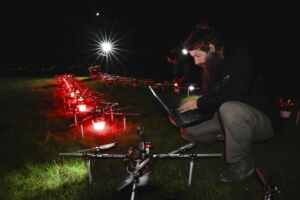
Image credit: AP News
5. New Geometric Shapes: “Soft Cell” and the “Bille”
Hungarian mathematicians are once again reshaping how we think about space—literally. From the celebrated Gömböc—the world’s first mono-monostatic self-righting body introduced in 2006 by Gábor Domokos and Péter Várkonyi—to the groundbreaking class of self-righting polyhedra in 2023, they have consistently redefined our understanding of geometry. In June 2025, Domokos and his team at BME — including one of his students, Gergő Almádi — unveiled another marvel: the ‘Bille,’ the world’s first monostable tetrahedron — a four-faced shape that always rights itself — which could transform how machines, spacecraft, and robots maintain balance.

The ‘Bille.’ Image credit: BME
In a parallel breakthrough, the Budapest University of Technology and Economics, in collaboration with Oxford, has now added ideal soft shapes to its legacy. Published in PNAS Nexus, these ‘soft cells’ are rounded spatial tilings found in nature—from seashells to muscle cells—offering clues to biological architecture and inspiring corner-free building designs. This discovery, building on decades of Hungarian innovation, underscores a national strength: geometry that both deepens scientific insight and promises real-world applications. Read more about Bille HERE, and Oxford University’s article on the ideal soft shapes.
6. AI for Hungarian Language: HuAMR & OpenHuEval
Hungarian researchers working on natural language processing have created HuAMR, the first dataset and tools to better understand the meaning of Hungarian sentences. They used Llama-based models combined with careful manual checking to improve how well computers can analyse Hungarian news texts. In early 2025, they also released OpenHuEval, the first test designed to check how well large language models handle tasks that are unique to the Hungarian language and culture.
7. Hungary Launches National SpaceLab Network to Boost Space Science
In July 2025, Hungary officially launched the Hungarian SpaceLab Network, uniting nine universities, two ministries, and the HUN-REN research network. The goal? To build the infrastructure, expertise, and institutional framework that will elevate Hungary’s role in global space science. The initiative reflects Hungary’s growing ambition in the space domain, from education and innovation to industrial applications and international missions. Learn more about the launch of the Hungarian SpaceLab Network and what it means for Hungary’s future in space exploration HERE.
